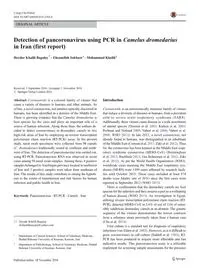
2017 Detection of pancoronavirus using PCR inCamelus dromedariusin Iran (first report) PDF
Preview 2017 Detection of pancoronavirus using PCR inCamelus dromedariusin Iran (first report)
ORIGINAL ARTICLE Detection of pancoronavirus using PCR in Camelus dromedarius in Iran (first report) Heydar Khalili Bagaloy1 & Ehsanollah Sakhaee1 & Mohammad Khalili2 Received: 5 September 2016 /Accepted: 1 November 2016 # Springer-Verlag London 2016 Abstract Coronaviride is a colossal family of viruses that cause a variety of diseases in humans and other animals. As of late, a novel coronavirus, not anterior-optically discerned in humans, has been identified in a denizen of the Middle East. There is growing evidence that the Camelus dromedarius is host species for the virus and plays an important role of a source of human infection. Along these lines, the authors de- cided to detect coronaviruses in dromedary camels in two high-risk areas of Iran by employing an reverse transcription polymerase chain reaction (RT-PCR) assay. In the present study, nasal swab specimens were collected from 98 camels (C. dromedarius) traditionally reared in southeast and north- west of Iran. The detection of pancoronavirus was carried out, using RT-PCR. Pancoronavirus RNA was observed in seven cases among 98 nasal swab samples. Among these, 4 positive samples belonged to Azerbaijan province located in northwest of Iran and 3 positive samples were taken from southeast of Iran. The results of this study contribute to raising the hypoth- esis to the extent of transmission and risk factors for human infection and public health in Iran. Keywords Pancoronavirus . RT-PCR . Camels . Iran Introduction Coronaviride is an astronomically immense family of viruses that induce a diversity of diseases in humans, from a prevalent cold to severe acute respiratory syndrome (SARS). Additionally, these viruses cause disease in a wide assortment of animal species (Drosten et al. 2003; Kuiken et al. 2003; Perlman and Netland 2009; Vabret et al. 2006; Vabret et al. 2008; WHO 2013). In late 2012, a novel coronavirus, not already found in humans, was distinguished in an inhabitant of the Middle East (Corman et al. 2011; Zaki et al. 2012). Thus far, the coronavirus has been kenned as the Middle East respi- ratory syndrome coronavirus (MERS-CoV) (Bermingham et al. 2012; Buchholz 2013; Van Boheemen et al. 2012; Zaki et al. 2012). As per the World Health Organization (WHO), worldwide cases meaning the Middle East respiratory syn- drome (MERS) were 1599 cases affirmed by research facili- ties until October 2015. These cases included at least 574 deaths (case fatality rate of 36%) since the first cases were reported in September 2012 (WHO 2015). There is confirmation that the dromedary camels are host species for the infection and they assume a part as a wellspring of human disease (WHO 2013). An investigation in Egypt, utilizing reverse transcription polymerase chain reaction (RT- PCR), detected MERS-CoV in 3.6% (4 out of 110) of osten- sibly salubrious dromedary camels in an abattoir. The genetic sequence of the viruses demonstrates the lowest contrasts from a reference strain previously taken from a human case (Chu et al. 2014). Viral culture is a standard test for diagnosis of respiratory infections (van Elden et al. 2002). However, as it is difficult to grow coronaviruses in cell culture (Siddell et al. 1983), RT- PCR has been produced to acquire more affectable and fast indicative results. This pancoronavirus assay is a utilizable implement for screening sample amassments for the presence * Heydar Khalili Bagaloy
